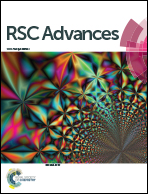TiO2 fibre/particle nanohybrids as efficient anodes for lithium-ion batteries†
Abstract
We report the synthesis of a TiO2 nanohybrid with a unique morphology consisting of TiO2 nanoparticles decorating the surface of TiO2 nanofibers, obtained by a simultaneous electrospinning and electrospraying technique, and its electrochemical studies as efficient anodes for the Li-ion battery. The TiO2-fiber/particle composite electrode exhibited a very high discharge capacity (190 mA h g−1 after 50 cycles, at C/10), excellent rate capability with remarkable capacity retention of 77% of initial capacity at 5C rate, and good cyclic stability, compared to TiO2 nanofibers and nanoparticles. The capacitive contribution from these electrodes is studied in detail by using cyclic voltammetry measurements, and the results are correlated with the overall electrochemical performance of the electrodes. The exceptional electrochemical characteristics exhibited by the TiO2-fiber/particle composite electrode, synthesized through a low-cost and scalable electrospinning technique, make it an ideal anode material for large-scale Li-ion battery applications.


 Please wait while we load your content...
Please wait while we load your content...